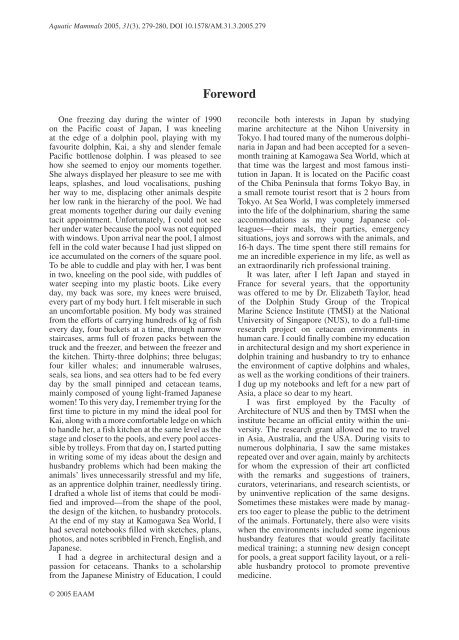Special Issue Survey of Cetaceans in Captive Care
Special Issue Survey of Cetaceans in Captive Care
Special Issue Survey of Cetaceans in Captive Care
You also want an ePaper? Increase the reach of your titles
YUMPU automatically turns print PDFs into web optimized ePapers that Google loves.
Aquatic Mammals 2005, 31(3), 279-280, DOI 10.1578/AM.31.3.2005.279ForewordOne freez<strong>in</strong>g day dur<strong>in</strong>g the w<strong>in</strong>ter <strong>of</strong> 1990on the Pacific coast <strong>of</strong> Japan, I was kneel<strong>in</strong>gat the edge <strong>of</strong> a dolph<strong>in</strong> pool, play<strong>in</strong>g with myfavourite dolph<strong>in</strong>, Kai, a shy and slender femalePacific bottlenose dolph<strong>in</strong>. I was pleased to seehow she seemed to enjoy our moments together.She always displayed her pleasure to see me withleaps, splashes, and loud vocalisations, push<strong>in</strong>gher way to me, displac<strong>in</strong>g other animals despiteher low rank <strong>in</strong> the hierarchy <strong>of</strong> the pool. We hadgreat moments together dur<strong>in</strong>g our daily even<strong>in</strong>gtacit appo<strong>in</strong>tment. Unfortunately, I could not seeher under water because the pool was not equippedwith w<strong>in</strong>dows. Upon arrival near the pool, I almostfell <strong>in</strong> the cold water because I had just slipped onice accumulated on the corners <strong>of</strong> the square pool.To be able to cuddle and play with her, I was bent<strong>in</strong> two, kneel<strong>in</strong>g on the pool side, with puddles <strong>of</strong>water seep<strong>in</strong>g <strong>in</strong>to my plastic boots. Like everyday, my back was sore, my knees were bruised,every part <strong>of</strong> my body hurt. I felt miserable <strong>in</strong> suchan uncomfortable position. My body was stra<strong>in</strong>edfrom the efforts <strong>of</strong> carry<strong>in</strong>g hundreds <strong>of</strong> kg <strong>of</strong> fishevery day, four buckets at a time, through narrowstaircases, arms full <strong>of</strong> frozen packs between thetruck and the freezer, and between the freezer andthe kitchen. Thirty-three dolph<strong>in</strong>s; three belugas;four killer whales; and <strong>in</strong>numerable walruses,seals, sea lions, and sea otters had to be fed everyday by the small p<strong>in</strong>niped and cetacean teams,ma<strong>in</strong>ly composed <strong>of</strong> young light-framed Japanesewomen! To this very day, I remember try<strong>in</strong>g for thefirst time to picture <strong>in</strong> my m<strong>in</strong>d the ideal pool forKai, along with a more comfortable ledge on whichto handle her, a fish kitchen at the same level as thestage and closer to the pools, and every pool accessibleby trolleys. From that day on, I started putt<strong>in</strong>g<strong>in</strong> writ<strong>in</strong>g some <strong>of</strong> my ideas about the design andhusbandry problems which had been mak<strong>in</strong>g theanimals’ lives unnecessarily stressful and my life,as an apprentice dolph<strong>in</strong> tra<strong>in</strong>er, needlessly tir<strong>in</strong>g.I drafted a whole list <strong>of</strong> items that could be modifiedand improved—from the shape <strong>of</strong> the pool,the design <strong>of</strong> the kitchen, to husbandry protocols.At the end <strong>of</strong> my stay at Kamogawa Sea World, Ihad several notebooks filled with sketches, plans,photos, and notes scribbled <strong>in</strong> French, English, andJapanese.I had a degree <strong>in</strong> architectural design and apassion for cetaceans. Thanks to a scholarshipfrom the Japanese M<strong>in</strong>istry <strong>of</strong> Education, I couldreconcile both <strong>in</strong>terests <strong>in</strong> Japan by study<strong>in</strong>gmar<strong>in</strong>e architecture at the Nihon University <strong>in</strong>Tokyo. I had toured many <strong>of</strong> the numerous dolph<strong>in</strong>aria<strong>in</strong> Japan and had been accepted for a sevenmonthtra<strong>in</strong><strong>in</strong>g at Kamogawa Sea World, which atthat time was the largest and most famous <strong>in</strong>stitution<strong>in</strong> Japan. It is located on the Pacific coast<strong>of</strong> the Chiba Pen<strong>in</strong>sula that forms Tokyo Bay, <strong>in</strong>a small remote tourist resort that is 2 hours fromTokyo. At Sea World, I was completely immersed<strong>in</strong>to the life <strong>of</strong> the dolph<strong>in</strong>arium, shar<strong>in</strong>g the sameaccommodations as my young Japanese colleagues—theirmeals, their parties, emergencysituations, joys and sorrows with the animals, and16-h days. The time spent there still rema<strong>in</strong>s forme an <strong>in</strong>credible experience <strong>in</strong> my life, as well asan extraord<strong>in</strong>arily rich pr<strong>of</strong>essional tra<strong>in</strong><strong>in</strong>g.It was later, after I left Japan and stayed <strong>in</strong>France for several years, that the opportunitywas <strong>of</strong>fered to me by Dr. Elizabeth Taylor, head<strong>of</strong> the Dolph<strong>in</strong> Study Group <strong>of</strong> the TropicalMar<strong>in</strong>e Science Institute (TMSI) at the NationalUniversity <strong>of</strong> S<strong>in</strong>gapore (NUS), to do a full-timeresearch project on cetacean environments <strong>in</strong>human care. I could f<strong>in</strong>ally comb<strong>in</strong>e my education<strong>in</strong> architectural design and my short experience <strong>in</strong>dolph<strong>in</strong> tra<strong>in</strong><strong>in</strong>g and husbandry to try to enhancethe environment <strong>of</strong> captive dolph<strong>in</strong>s and whales,as well as the work<strong>in</strong>g conditions <strong>of</strong> their tra<strong>in</strong>ers.I dug up my notebooks and left for a new part <strong>of</strong>Asia, a place so dear to my heart.I was first employed by the Faculty <strong>of</strong>Architecture <strong>of</strong> NUS and then by TMSI when the<strong>in</strong>stitute became an <strong>of</strong>ficial entity with<strong>in</strong> the university.The research grant allowed me to travel<strong>in</strong> Asia, Australia, and the USA. Dur<strong>in</strong>g visits tonumerous dolph<strong>in</strong>aria, I saw the same mistakesrepeated over and over aga<strong>in</strong>, ma<strong>in</strong>ly by architectsfor whom the expression <strong>of</strong> their art conflictedwith the remarks and suggestions <strong>of</strong> tra<strong>in</strong>ers,curators, veter<strong>in</strong>arians, and research scientists, orby un<strong>in</strong>ventive replication <strong>of</strong> the same designs.Sometimes these mistakes were made by managerstoo eager to please the public to the detriment<strong>of</strong> the animals. Fortunately, there also were visitswhen the environments <strong>in</strong>cluded some <strong>in</strong>genioushusbandry features that would greatly facilitatemedical tra<strong>in</strong><strong>in</strong>g; a stunn<strong>in</strong>g new design conceptfor pools, a great support facility layout, or a reliablehusbandry protocol to promote preventivemedic<strong>in</strong>e.© 2005 EAAM


